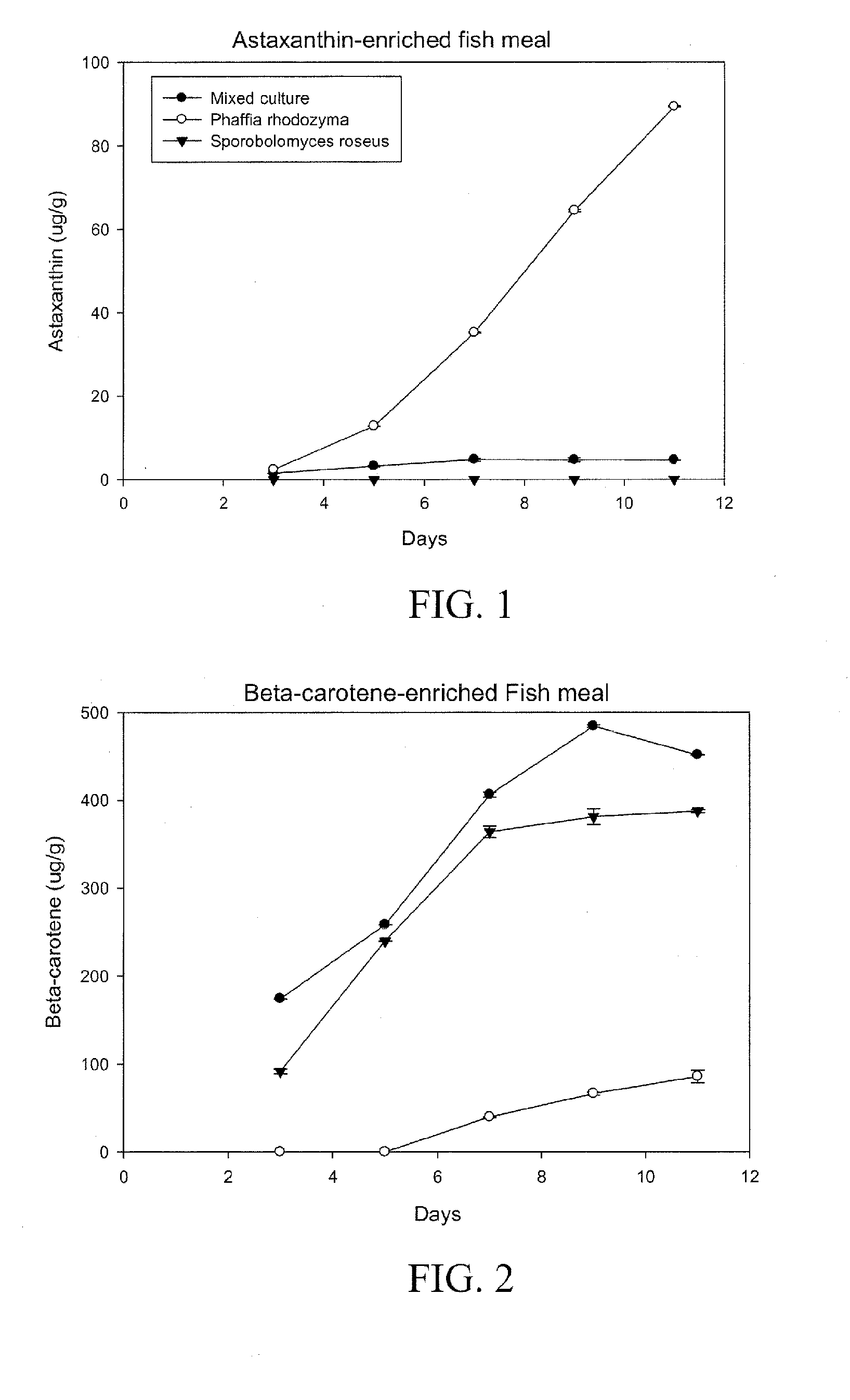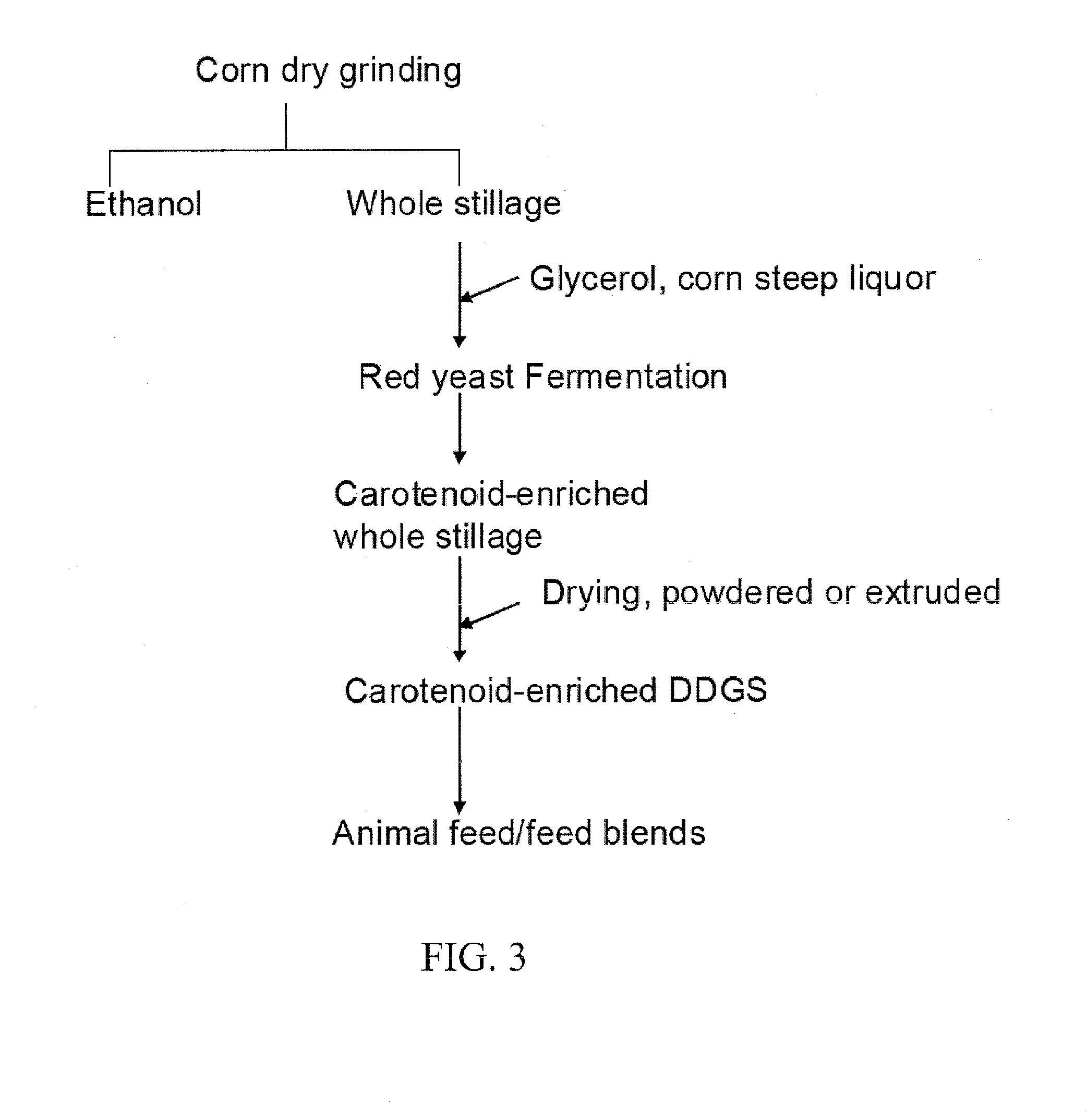Fermentation process to produce natural carotenoids and carotenoid-enriched feed products
a technology of natural carotenoids and carotenoid enriched feed products, which is applied in the field of in situ fortification of animal feed products, can solve the problems of increased feed production costs, poor quality of animal feed, and poor quality of desirable nutrients
- Summary
- Abstract
- Description
- Claims
- Application Information
AI Technical Summary
Benefits of technology
Problems solved by technology
Method used
Image
Examples
example 1
[0038]In this example, the preparation of a carotenoid-rich fish meal product was examined using fermentation processes. Lyophilized cultures of red yeasts P. rhodozyma (ATCC 24202) and S. roseus (ATCC 28988) were obtained from American Type Culture Collection (ATCC, Manassas, Va.). Astaxanthin and β-carotene were the only carotenoids examined in this study. The selected strain of P. rhodozyma produces astaxanthin and β-carotene, whereas the S. roseus strain produces only β-carotene.
[0039]Inoculum was prepared by inoculating a loopful of cells from respective slants into sterile 100 ml yeast extract malt extract broth (YMB) in 500 ml flasks and incubated at 18° C. and 180 rpm for 72 h. Development of orange and red color in P. rhodozyma and S. roseus flasks, respectively, indicated good fungal growth. A 10% (v / v) inoculum was used. For monoculture fermentation, 10 ml of each strain was used for media inoculation, and 5 ml of each strain was used for mixed culture fermentation.
[0040]...
example 2
[0047]In this example, the preparation of carotenoid-rich animal feeds from plant-based materials was examined using fermentation processes. Lyophilized cultures of red yeasts P. rhodozyma (ATCC 24202) and S. roseus (ATCC 28988) were obtained from American Type Culture Collection (ATCC, Manassas, Va.).
[0048]Inoculum for each fungal strain was prepared by inoculating a loopful of cells from respective slants into sterile 100-mL yeast extract-malt extract broth in 500-mL flasks and incubating them at 18° C. and 180 rpm for 72 hr. Development of orange and red color in P. rhodozyma and S. roseus flasks, respectively, indicated good fungal growth. A 10% (v / v) inoculum was used. For monoculture fermentation, 10 mL of each strain was used for media inoculation, and 5 mL of each strain was used for mixed-culture fermentation.
[0049]Eight substrates were used in this study: defatted and full-fat rice bran (Nutracea, Phoenix, Ariz.), milo (grain sorghum) whole stillage (Nesika Energy, Scandia...
example 3
[0063]In this example, the preparation of carotenoid-rich animal feeds from corn whole stillage was examined using secondary fermentation processes. Lyophilized cultures of Phaffia rhodozyma (ATCC 24202) and Sporobolomyces roseus (ATCC 28988) were obtained from the American Type Culture Collection (ATCC, Manassas, Va., USA), revived on yeast extract malt extract agar (YMA), and incubated at 18° C. for 10 days. After revival, cultures were inoculated into yeast extract malt extract broth (YMB) and incubated at 18° C. on an orbital shaker at 180 rpm for 5 days. Cultures were then inoculated on YMA slants, incubated for 10 days, and later stored at −80° C. for long-term preservation. Additionally, yeast cells from YMB were centrifuged and resuspended in 20% glycerol and stored at −80° C. in one ml aliquots. For routine experiments, freshly prepared slants were used. Phaffia rhodozyma ATCC 24202 is a known carotenoid producer and has xylose-metabolizing ability.
[0064]From each fungal st...
PUM
| Property | Measurement | Unit |
|---|---|---|
| Mass | aaaaa | aaaaa |
| Dimensionless property | aaaaa | aaaaa |
| Dimensionless property | aaaaa | aaaaa |
Abstract
Description
Claims
Application Information
 Login to View More
Login to View More - R&D
- Intellectual Property
- Life Sciences
- Materials
- Tech Scout
- Unparalleled Data Quality
- Higher Quality Content
- 60% Fewer Hallucinations
Browse by: Latest US Patents, China's latest patents, Technical Efficacy Thesaurus, Application Domain, Technology Topic, Popular Technical Reports.
© 2025 PatSnap. All rights reserved.Legal|Privacy policy|Modern Slavery Act Transparency Statement|Sitemap|About US| Contact US: help@patsnap.com


